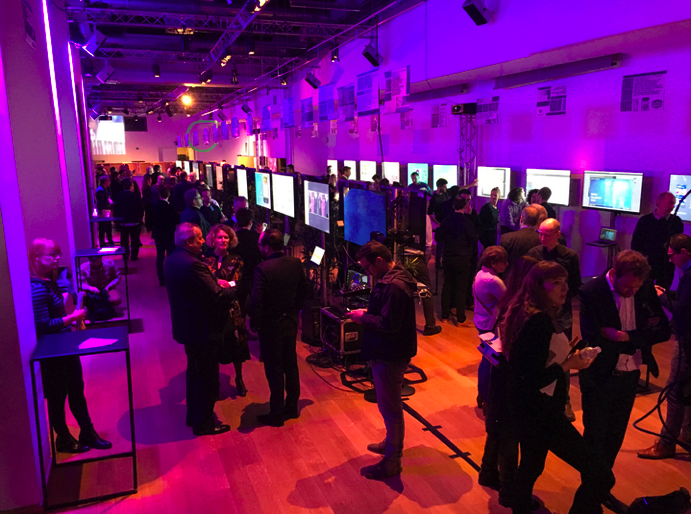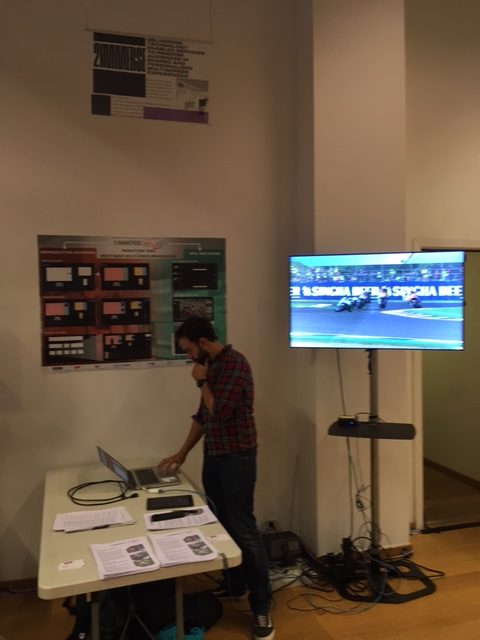A Day in Brussels: showcasing our production tools
PABLO CESAR, JIE LI and THOMAS RÖGGLA from project partner CWI Amsterdam report on a successful showcase in Brussels:
Vlaamse Radio- en Televisieomroeporganisatie (VRT), the national public-service broadcaster for the Flemish Region and Community of Belgium, organizes every year a networking event on media innovation: Media Fastforward. This year it happened in the beautiful location of Bozar in Brussels on 5 December. VRT Innovatie invited a number of European research projects to participate in the Future Zone.

Media Fastforward, focusing on media innovation, fits well the networking and dissemination needs of 2IMMERSE, providing a unique opportunity to meet with others and to showcase the results of the project. So the CWI team packed their bags, taking along a demo about our object-based multi-screen broadcasting, with an emphasis on the live-triggering tool intended for sports events such as football or MotoGP races.

Our demo showed a working prototype of our tool, interfacing with the 2IMMERSE platform, that in real-time could trigger broadcast events, showing and hiding collections of objects. The tool aims to reduce the workload during live broadcasting by providing templates for certain events (e.g., crashes, overtakes in MotoGP). The template resembles a ‘data package’, including graphics, placeholders for camera feeds, and scripts describing sequences of contents within this event.

The event was a huge success with around one thousand registered visitors, 25 (inter-)national speakers, more than 40 startups, 12 research projects and 3 impressive tech companies. It allowed us to interact with peer projects like FLAME, MOS2S and ImmersiaTV, and show and discuss about our production tools with entrepreneurs, media professionals, and policy makers.
Yes, we also had as well some extra time to relax with bike games and alcohol-free mojitos; we will certainly be back next year!
READ MOREFake News at NEMS 2017
DOUG WILLIAMS from BT R&D reports from Madrid:
This year’s NEM Summit in late November gave me an opportunity to present some of our 2-IMMERSE work but also to hear some updates on key policy concerns. The most prominent issue appeared to be the need to develop a response to the deleterious effects of fake news. This is a tricky area where you have to fish lies from the treacherous waters that run between the right to free speech and the nuances of subjectivity.
There were two great, and I’d say encouraging, presentations from those closely involved in ensuring veracity. They were given by Jochen Spangenberg from Deutsche Welle and Kristoffer Egeberg from the Norwegian fact checking organisation Faktisk; Faktisk has a nice back story as it was created from a cooperation between normally competitive print rivals in Norway.
Jochen told us about some good practice in journalism; whilst he mentioned some clever tools that allow you to check the authenticity of photographs and even videos using on line tools, Jochen also emphasised the value of old fashioned practice, like picking up the phone! Jochen seemed to me to be providing guidance to well-meaning journalists to help prevent them promulgating lies through neglect – he was essentially describing good journalism. Kristoffer was offering a method that could counter the occasions when through malice, ignorance or laziness lies start to spread widely.
To do this effectively and to try and retain independence and credibility Faktisk have adopted at least two clever principles. The first is the way they decide what stories to check. They check top trending stories – so they don’t ‘go after’ groups with a particular political standpoint; instead they focus on checking the veracity of the stories seen by most people.Faktisk use a nuanced traffic light system to give their judgements, and their measures range from ‘totally true’ through ‘true but provided in a wrong context’ through to just ‘lies’.
The second thing they do that seems important is to make the judgements they publish freely available; this has resulted in the results of the fact checking being picked up and run as stories through many established publication channels. On occasions, the Faktisk output has thus become more popular than the original story – as a rebuttal to lies this seems more effective than a delayed correction hidden on page 13. Faktisk hasn’t been going long but already has achieved a reach of about 1.3 million individual users in a population of 5 million. That seems exceptional.
I found these reports encouraging. It is clear that there will be no machine that will stop lies spreading and that tools, process and good practice are what is needed. At a historical moment when heads of state are retweeting stories that are not only not true but also full of hate it is pleasing that we can see methods that should limit lies being published accidentally and to call out and make their status known.
READ MORE

